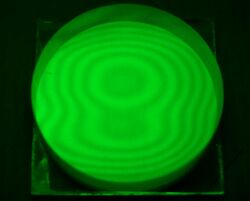Physics:Window (optics)

In optics, a window is an optical element that is transparent to a range of wavelengths, and that has no optical power. Windows may be flat or curved. They are used to block the flow of air or other fluids while allowing light to pass into or out of an optical system.
General characteristics
In general, an optical window is a material that allows light into an optical instrument. The material has to be transparent to a wavelength range of interest but not necessarily to visible light.[1] Usually, it is mechanically flat and sometimes it also is optically flat, depending on resolution requirements.[2] A window of this sort is commonly parallel[1] and is likely to be anti-reflection coated, especially if it is designed for visible light.[3] An optical window may be built into a piece of equipment (such as a vacuum chamber) to allow optical instruments to view inside that equipment.[4]
In spectroscopy
Optical windows used for UV/VIS spectroscopy, are usually made from glass or fused silica.[5] In IR spectroscopy, there is a wide range of materials that transmit light into the far infrared and can be utilized for the construction of optical windows, from barium fluoride (BaF2), calcium fluoride, potassium bromide, potassium chloride, sodium chloride, germanium (Ge), zinc selenide (ZnSe) and sapphire.[6][7] These windows are either built into circular, elliptical or rectangular configurations.[8]
References
- ↑ Jump up to: 1.0 1.1 Vukobratovich, Daniel; Yoder, Paul (2018) (in en). Fundamentals of Optomechanics. CRC Press. pp. 63. ISBN 978-1-4987-7075-0. http://www.worldcat.org/oclc/1020287047.
- ↑ Soares, Olivério D. D. (1987) (in en). Optical Metrology: Coherent and Incoherent Optics for Metrology, Sensing and Control in Science, Industry and Biomedicine. Springer Science & Business Media. pp. 347. ISBN 978-94-009-3609-6. http://www.worldcat.org/oclc/716678158.
- ↑ Vukobratovich, Daniel; Yoder, Paul (2018) (in en). Fundamentals of Optomechanics. CRC Press. pp. 240. ISBN 978-1-4987-7075-0. http://www.worldcat.org/oclc/1020287047.
- ↑ Auciello, Orlando; Krauss, Alan R. (2001) (in en). In Situ Real-Time Characterization of Thin Films. John Wiley & Sons. pp. 73. ISBN 978-0-471-24141-6. http://www.worldcat.org/oclc/804229641.
- ↑ Lindon, John C. (2016) (in en). Encyclopedia of Spectroscopy and Spectrometry. Academic Press. pp. 572. ISBN 978-0-12-803225-1. http://www.worldcat.org/oclc/946605179.
- ↑ Aprile, Elena; Bolotnikov, Aleksey E.; Bolozdynya, Alexander I.; Doke, Tadayoshi (2006) (in en). Noble Gas Detectors. John Wiley & Sons. pp. 249. ISBN 978-3-527-40597-8. http://www.worldcat.org/oclc/804153176.
- ↑ Alvarez-Ordóñez, Avelino; Prieto, Miguel (2012) (in en). Fourier Transform Infrared Spectroscopy in Food Microbiology. Springer Science & Business Media. pp. 8. ISBN 978-1-4614-3813-7. http://www.worldcat.org/oclc/780478164.
- ↑ Vukobratovich, Daniel; Yoder, Paul (2018) (in en). Fundamentals of Optomechanics. CRC Press. pp. 64. ISBN 978-1-4987-7075-0. http://www.worldcat.org/oclc/1020287047.
 |

